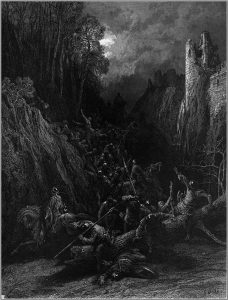 Have you ever had a chase scene in your favorite tabletop RPG? Was it fun and exciting?
Have you ever had a chase scene in your favorite tabletop RPG? Was it fun and exciting?
I didn’t think so. Chase scenes are a staple in adventure films, but RPG rules seldom tackle them, at least not well.
Long-distance chases aren’t much of a problem. These are situations like Butch Cassidy and the Sundance Kid trying to escape from Charlie Siringo and the Pinkertons, or Aragorn, Legolas, and Gimli trying to overtake the orcs carrying Merry and Pippin back toward Isengard. Chases like that come down to miles per hour, hours per day, and tracking. If the pursuers are faster than their quarry or can keep moving when their quarry stops, then they will catch up, provided they don’t take a wrong turn somewhere. Most RPGs can handle those questions with skills. When the chase is measured in hours or days, no one is disappointed with a high level of abstraction.
A short-distance, high-speed chase is where things get exciting. Speed, agility, and alertness are key when pursuing your target at a dead sprint up busy streets, down narrow alleys, through crowds, and over and around obstacles. A few abstract dice rolls won’t cut it. Players want to make actual decisions about where to turn, how to shake off the guards, and whether to dodge the wedding party or plow right through it.
What I’m presenting here is a way to quickly map a foot chase through crowded city with zero prep work but infinite variety in the layout.
Since I don’t know what game you’re playing, the rules of the chase are up to you. Use your game’s standard system for determining speed, spotting, leaping, and dodging.
You’ll need a standard deck of 52 playing cards (jokers optional) and a fistful of d6s. The cards represent areas where things happen. Dice mark the distance between areas. Shuffle the cards, scrape the dice into a pile, and you’re ready.
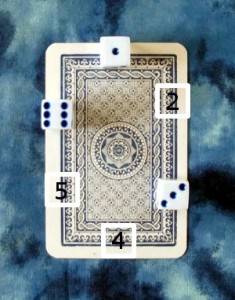 Step 1: The Chase Is On. Take the top card off the deck and place it face down on the table. This is where the chase begins. You’ve already described this area to the players, so the scene is set.
Step 1: The Chase Is On. Take the top card off the deck and place it face down on the table. This is where the chase begins. You’ve already described this area to the players, so the scene is set.
Step 2: Count the Exits. Roll three dice. Put each one on the edge of the card as shown in the first photo, depending on what number came up on the die. In the case of doubles, discard one of the matching dice. Each die placed on the edge of the card represents a street or alley leading out of this area. The quarry is going to take one of the exits. They have a head start; how much depends on your game.
Step 3: How Far to the Next Exit? Pick up the die marking the route that the quarry took, roll it, and place it back where it was, but adjacent to the card instead of on it. It now represents a path, and the number that you rolled is the distance to the next card. The actual distance represented by each pip depends on the game being played. For a foot chase, something along the lines of the distance that an average human can run in 10-20 seconds is a good starting point. In the photo, for example, the path of length 4 would take a normal human about a minute to race through.
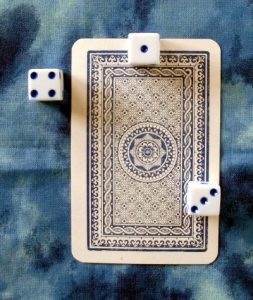 Step 4: Where Are We Now? Draw the next card and place it face-up adjacent to the path. Cards are always placed in a staggered, brick pattern, as shown in the photos. The card that was drawn determines what the new area is; see the lists below. Most areas are just descriptive, but a face card or a joker means a hazard is involved. A hazard must be dealt with before moving on.
Step 4: Where Are We Now? Draw the next card and place it face-up adjacent to the path. Cards are always placed in a staggered, brick pattern, as shown in the photos. The card that was drawn determines what the new area is; see the lists below. Most areas are just descriptive, but a face card or a joker means a hazard is involved. A hazard must be dealt with before moving on.
Step 5: Where to Next? Roll three dice and arrange them around the new card the same way you did on the starting card. These are the exits. Discard any duplicate numbers and any die that lines up with the spot where the chase came into this area.
Step 6: Cheese It! The quarry picks an exit, you roll that die to determine the distance and place it to mark the path, and draw and place a card to see what the new area is.
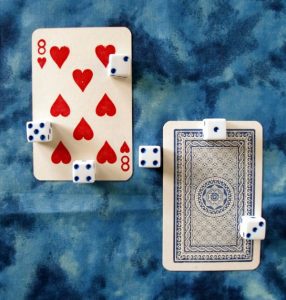 Step 7: Repeat as Necessary. The chase continues from area to area until either the quarry is caught or the pursuer is shaken off.
Step 7: Repeat as Necessary. The chase continues from area to area until either the quarry is caught or the pursuer is shaken off.
Areas and Hazards
A card’s suit determines the general nature of an area.
Spade: moderate to upscale homes and shops, guild halls
Club: moderate to shabby homes and shops, dingy taverns
Heart: plaza, square, park, other open area
Diamond: bazaar, docks, warehouses, religious or government buildings, military zone
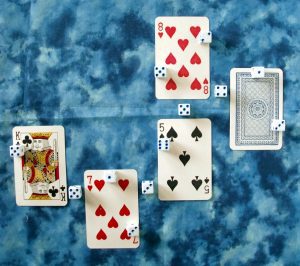 The card’s value determines in a rough way the area’s condition or status. For example, the 9 of clubs would be a middle-class area, while the 2 of clubs probably is a slum. The 9 of diamonds might be a cathedral square, while the 2 of diamonds is a seedy warehouse district. Let your imagination run. Aces are low.
The card’s value determines in a rough way the area’s condition or status. For example, the 9 of clubs would be a middle-class area, while the 2 of clubs probably is a slum. The 9 of diamonds might be a cathedral square, while the 2 of diamonds is a seedy warehouse district. Let your imagination run. Aces are low.
Hazards: Face cards represent hazards to be avoided. The listing here is only a suggestion, suitable for a large medieval or fantasy city such as Lankhmar or Waterdeep. Make your own lists to represent the locations and genres in play. As with other specifics, how these hazards actually affect play depends on the rules being used and is left in the GM’s hands.
| Club | Diamond | Heart | Spade | |
| (lower class) | (other) | (plaza) | (upper class) | |
| Jack | gang of urchins | crowded market | street fair | stuck wagon |
| Queen | loose livestock | religious procession | wedding party | guard patrol |
| King | altercation | construction | parade | passing nobles |
A joker represents something truly significant: the King riding through the street, a wizard who really doesn’t like being bumped into, a row of houses burning down, or any other suitably large monkey wrench. Or, you can leave the jokers out and not bother with them.
Variants: I’ll suggest ways to vary and adapt this approach on Wednesday over at howlingtower.com.
About the Author
Steve Winter has been involved in publishing Dungeons & Dragons in one capacity or another since 1981. Currently he’s a freelance writer and designer in the gaming field. You can visit Steve and read more of his thoughts on roleplaying games, D&D, and more at his website: Howling Tower. If you missed the first of these entries on the Kobold Quarterly site, please follow the Howling Tower tag to read more!

Great fun – will have to give this a try!
Enjoying the Howling Tower articles! This one sounds like alot of fun and I am going to try it out.
If you do try it out (and I plan to this Friday or next), please do let Steve know how it goes.
This looks like a great way to make close-range chase scenes feel more immediate! Now I want to find a way to work a chase scene into my next game. . . .
I have had great fun using Paizo’s chase cards.
I love it! But, yes, I have had fun and exciting chases in RPGs. Spycraft has some good ideas in the Dramatic Challenges that PCs can face, including chases. There is a deck and predator and prey sides each choose strategies and these affect lead distances or even swap predator and prey, cause crashes, etc. It takes some experience to run really well, but the system is pretty cool.
I also think we did a chariot chase very well in D&D 4E with Ashes of Athas AOA1-3. This was a combination of skill challenge with scenes that determine how the chase progresses, followed by either the prey catching the party or the party catching the prey. There were then encounter mechanics for the passing terrain, the driver to use the chariot for ramming, jumping from chariot to chariot, falling off, etc. The design goal was Indiana Jones and I’m really happy with how much fun it was for tables.
One of the issues with the Paizo chase mechanics was that they were aimed at two entities – predator and prey. They didn’t handle multiple parties in a chase nor really did they handle pursuers or allies of the prey showing up mid-chase.
The concept is great… but some way to elegantly manage multiple parties needs to be developed.
I like the concept! Adds not only a nice dimension to an action sequence, but a dynamic one at that!
However, one thing I’m missing is how to determine when the target gets caught up to and/or caught. ??
@Saurstalk: Try this method to determine who is gaining or loosing ground. I’ve used in in my game for decades.
When characters are in a chase, I let each one roll 1d6 every round for “extra movement”. Rolling a 1 means you moved your normal allotment plus 5 feet. Rolling a 6 lets you move your normal allotment plus 30 feet.
Every time a hazard is encountered, the one(s) trying to escape can “sacrifice” their extra movement to try making the hazard “worse”. This can be anything from slamming a door, to knocking over a vendor’s cart filled with sharp objects. However, it must always be something that is fast and easy to accomplish. Depending on the exact situation, an ability check or a skill check is required to see if they really made the pursuit more difficult.
If they succeed, the ones doing the chasing loose one round of movement while trying to pry open the door, clear a path through the knife-infested alley, etc.
Note: This does favor the ones being pursued. However, it keeps chases from having “inevitable” conclusions based on who has the better base movement rate.
Also note: I’ve only used this for land chases. I’ve never needed a variation to handle flying or swimming chases.
Hi! I just used your ruleset as the basis of my own postapocalyptic version – thanks for the inspiration!
I like the card basis and the notion of a chase as more of a collection of decisions rather than a blow-by-blow.
I just read an article exploring whether writers’ prose could represent fight scenes like those in John Wick.
(https://www.maxgladstone.com/2015/04/fighting-words/)
It recognized that the way that books describe fearsome villains isn’t the same sort of visual manner a movie would. The movie shows you detail, choreography, slow-mos, tempo changes in the music, plays of light and shadow, etc. But a straight out description in prose would be lengthy and thus lose interest.
Books have to look to the essence of a scene or character, then use the tools of prose to convey that essence. It won’t (can’t) be the same as the means used in movies, but in its own way, it can leave an impression that could be reminiscent of a big screen fight. It also has nuances and ways of approaching things that would require a very different approach on the screen.
This difference of media and of the tools to present explains why so many great books struggle to find a great movie representation and why some great film experiences would not directly or easily translate to prose.
The details could not be the same, but the essence could in fact exist in both representations.
So this method of handling chases is both inspired and appropriate for the time and depth that one has time for in an RPG scene.